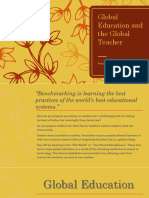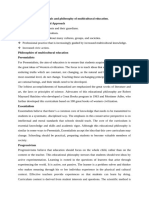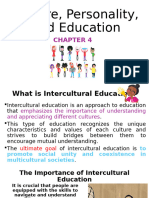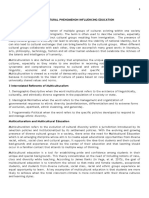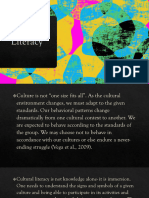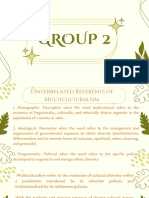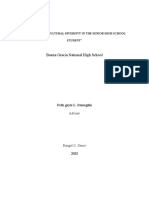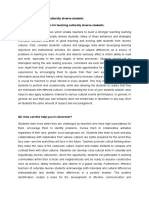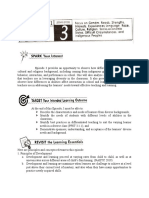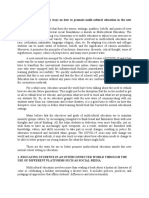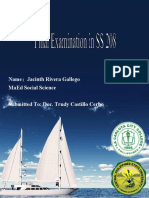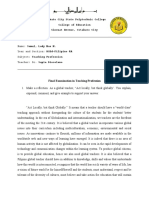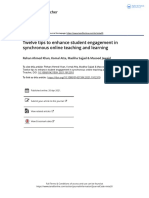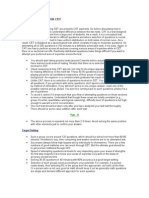Building and Enhancing New Literacies Across The Curriculum
Building and Enhancing New Literacies Across The Curriculum
Uploaded by
Adora ortegoCopyright:
Available Formats
Building and Enhancing New Literacies Across The Curriculum
Building and Enhancing New Literacies Across The Curriculum
Uploaded by
Adora ortegoOriginal Title
Copyright
Available Formats
Share this document
Did you find this document useful?
Is this content inappropriate?
Copyright:
Available Formats
Building and Enhancing New Literacies Across The Curriculum
Building and Enhancing New Literacies Across The Curriculum
Uploaded by
Adora ortegoCopyright:
Available Formats
BUILDING AND ENHANCING NEW LITERACIES ACROSS THE CURRICULUM
Module Five: Multicultural and Global Literacy
Activity 1
Instruction: Discuss the following idea.
1. What do you mean by multicultural and global literacies?
Multicultural literacy it consists of the skills and ability to identify the creator of knowledge and their interest.
The ability to understand and appreciate the parallels and differences between customs, values, and beliefs of your
culture and a different culture. It is a race to sensitivity and awareness of every people around us. For example, if we are
going to teach values education, we need to respect the cultures of that student. We need to be fair enough for the
learners to understand what we are teaching we should have multicultural literacy, this is what we should theach our
awreness. Because if we are going to propose something into that student we need to deal with their culture also,
because as a teacher we need to be equal to those diverse student. If not there will be conflict happen between you and
that student because of different cultural backgrounds. Multicultural literacy must help learners to agents of social
justice among communities. It must be a bridge to diversity.
Global Literacy aims to address issurs of globalization, racism, diversity and social justice. Students that are
globally literate may think critically about the world and their own place in it. These pupils are aware of and appreciate
the diverse cultures, practices, institutions, and relationships that exist around the world. Students that are globally
literate have the potential to make a positive impact on the world. It brings awareness of the possibilities and constraints
facing the world’s people.
2. Explain the Global Competence Framework.
Global competence is the ability to examine local, global, and intercultural issues, to understand and appreciate
others' perspectives and world views, to interact with people from different cultures in an open, appropriate, and
effective manner, and to act for collective well-being and sustainable development. It prepares the learners to succeed in
a world that is more varied and interconnected. The capacity to be involved citizens and collaborative problem solvers
who are ready for the workforce is critical in today's fast changing environment. This is what everyone will require in
the twenty-first century and beyond. Citizens who are actively involved. To be well-prepared for future careers. To be
problem solvers on a local and global scale.
3. What are the dimensions of multiculturalism? Explain each.
Content Integration examines how teachers utilize examples and information from many cultures and groups
to convey fundamental concepts, principles, generalizations, and theories in their subject area or field.
Transform the curriculum by focusing on themes and situations and considering them from a range of cultural
viewpoints. They employ text and materials from various cultures in the classroom.
Knowledge construction process refers to educational activities that assist students comprehend, analyze, and
discover how researchers' and textbook authors' implicit cultural assumptions, frames of reference, viewpoints,
and biases impact how knowledge is generated. While reading textbooks, the instructor shares tales from other
perspectives, rewrites stories from the perspective of another character, and engages in critical thinking.
Equity Pedagogy arises when teachers adapt their instruction to help students from a variety of ethnic,
cultural, socioeconomic, and linguistic backgrounds achieve academic success. This includes employing a
variety of teaching techniques and procedures that are compatible with the many learning patterns seen among
various cultural and ethnic groups, such as being tough yet highly customized. It changes the way people learn
by using a number of strategies. The objective is for every learner to succeed, and this includes incorporating
students' family and community cultures.
Prejudice Reduction it help pupils acquire good and democratic race attitudes by decreasing prejudice in
them. It also enables pupils to comprehend how the setting of schooling, as well as the attitudes and beliefs of
dominant social groups, impact ethnic identification. It improves people's perceptions of race and ethnicity.
Teaching tools with realistic depictions of ethnic and racial groupings. Teacher uses visuals, literature, and
relevant examples of individuals from many backgrounds to fill the room.
An Empowering School Culture entails changing the school's culture and organization to ensure that pupils
from various racial, ethnic, socioeconomic, and linguistic groups are treated equally. The culture and social
structure of the school are examined and changed by members of the school personnel. provides opportunity
for teachers to collaborate on planning and instruction, as well as democratic frameworks that allow teachers,
parents, and school employees shared responsibility for school governance.
4. How can global competence and global understanding be assessed in the curriculum?
Globally competent individuals can examine local, global and intercultural issues, understand and appreciate different
perspectives and world views, interact successfully and respectfully with others, and take responsible action toward
sustainability and collective wellbeing. As students continue to communicate respectfully with one another and engage
responsibly in today's society, including global competency assessment into the classroom can result in tremendous
transformations. Every school should provide support to its pupils to help make sense of the most critical issues concerns that
are shaping our era The high expectations put on schools to assist kids in coping and flourish in a world that is becoming
increasingly linked Education is the only way to ensure that the environment is protected. New learning objectives are defined
by systems depending on the data. On a firm foundation, and employ a variety of techniques
An evaluation to consider the efficacy of their endeavors, as well as their instructional methods
5. How can you integrate multicultural and global literacies in the lesson using appropriate delivery strategies,
assessment tools, and instructional materials?
We all know that Multicultural Literacies is the capacity to recognize each student's knowledge and interests,
which why instructional materials must include certain activities that will capture their interest and allows them to
communicate to enhance their knowledge. For example, we know that students enjoy completing exciting and
challenging tasks, such as laboratory activities, and that is the way they can demonstrate their eagerness for this type of
learning by doing so. And in Global Literacy, we know that this literacy addresses the issue of globalization, racism,
diversity and social justice especially on diverse students. We can offer them an activity like internet surfing and
searching for things that are relevant to what is going on in the world right now, so they can form a synthesis of what
they read online. We can attain the objective of providing children with information about what is going on in the world
by participating in this activity. This is the consequence of every teacher's direct practical application of their lessons,
teaching tactics, and instructional materials, which leads to the development of theories of knowledge that incorporate
the students' learnings in order to produce meaningful results.
You might also like
- Post-Test 1 - Planning and Organizing Competency AssessmentDocument5 pagesPost-Test 1 - Planning and Organizing Competency AssessmentJude Metante100% (1)
- Concept of Building A Culturally Friendly Classroom EnvironmentDocument12 pagesConcept of Building A Culturally Friendly Classroom EnvironmentFatihah Nawawi100% (8)
- MULTICULTURALDocument21 pagesMULTICULTURALRhea Jane TanNo ratings yet
- Activity.5 MulticulturalismDocument3 pagesActivity.5 MulticulturalismGARCIA EmilyNo ratings yet
- Hamza MulticultureDocument6 pagesHamza Multicultureabelermias24No ratings yet
- Pame Marvin Module 5Document3 pagesPame Marvin Module 5Marvin Pame100% (4)
- Course Four: Culture of Understanding: Unit 1: Multicultural Education Learning ObjectivesDocument15 pagesCourse Four: Culture of Understanding: Unit 1: Multicultural Education Learning ObjectivesTeachers Without Borders100% (1)
- AnswerDocument8 pagesAnswerAiron Kent TijamNo ratings yet
- Multicultural Literacy and Social Literacy - FinalDocument43 pagesMulticultural Literacy and Social Literacy - FinalMERRY LOVELY DELA CRUZNo ratings yet
- Culture, Personality, and EducationDocument41 pagesCulture, Personality, and EducationHannah AGNo ratings yet
- Literacy Module 4Document5 pagesLiteracy Module 4Shane GempasaoNo ratings yet
- Cultural Diversity 205Document18 pagesCultural Diversity 205Allana PonceNo ratings yet
- Addressing Literacy Needs in Culturally and LinguisticallyDocument28 pagesAddressing Literacy Needs in Culturally and LinguisticallyPerry Arcilla SerapioNo ratings yet
- Teaching in DiversityDocument12 pagesTeaching in DiversityBertrand Aldous Santillan100% (1)
- Cultural Proficiency ResourcesDocument5 pagesCultural Proficiency Resourcesapi-240756804No ratings yet
- Culture, Personality, and EducationDocument41 pagesCulture, Personality, and EducationHannah AGNo ratings yet
- Culturally Responsive Final PaperDocument7 pagesCulturally Responsive Final Paperirenealarcon7No ratings yet
- Ed 680 Final Reflection EssayDocument5 pagesEd 680 Final Reflection Essayapi-508948800No ratings yet
- Prof Ed 5 MidtermDocument25 pagesProf Ed 5 MidtermDojonel ValdezNo ratings yet
- Socio-Cultural Phenomenon Influencing EducationDocument4 pagesSocio-Cultural Phenomenon Influencing Educationofelia acostaNo ratings yet
- Why Focus On Cultural Competence and Culturally Relevant Pedagogy?Document4 pagesWhy Focus On Cultural Competence and Culturally Relevant Pedagogy?yankumi07No ratings yet
- What Is Curriculum DesignDocument6 pagesWhat Is Curriculum DesignSantos CarrascoNo ratings yet
- Lesson 7 Becoming A Glocal and Global Teacher New 1Document6 pagesLesson 7 Becoming A Glocal and Global Teacher New 1NiellaNo ratings yet
- Reading 7 6 Ways To Implement A Real Multicultural Education in The ClassroomDocument3 pagesReading 7 6 Ways To Implement A Real Multicultural Education in The ClassroomAizuddin bin RojalaiNo ratings yet
- Cultural Literacy and Multicultural LiteracyDocument25 pagesCultural Literacy and Multicultural Literacyhcb4341No ratings yet
- PU Philosophy of Multicultural EducationDocument40 pagesPU Philosophy of Multicultural Educationcluadine dinerosNo ratings yet
- Group 2Document35 pagesGroup 2Random PersonNo ratings yet
- Profed9 EssayDocument6 pagesProfed9 Essayalmaalana.detablanNo ratings yet
- MULTICULTURALISM FinalDocument34 pagesMULTICULTURALISM FinalDominic Rito100% (1)
- A Reflection On 5 Dimensions of Multicultural EducationDocument6 pagesA Reflection On 5 Dimensions of Multicultural EducationNicole Damian BorromeoNo ratings yet
- Kuda BaeletseDocument11 pagesKuda BaeletseTheodorah MbedziNo ratings yet
- Teaching Strategies in A Multicultural Classroom: Prachi NaddaDocument3 pagesTeaching Strategies in A Multicultural Classroom: Prachi NaddaRobert SolisNo ratings yet
- Article ReadingDocument7 pagesArticle Readingapi-289249800No ratings yet
- Multicultural Perspective Lesson 2Document23 pagesMulticultural Perspective Lesson 2Ameil OrindayNo ratings yet
- TRF 6 by KathDocument15 pagesTRF 6 by KathCarl Justin BingayanNo ratings yet
- Multiculturalism Project 2Document10 pagesMulticulturalism Project 2api-247283121No ratings yet
- Chapter 1-3 - RangelDocument17 pagesChapter 1-3 - Rangelraisy jane senocNo ratings yet
- EDU 103 H3 Role of A Teacher in A Changing WorldDocument7 pagesEDU 103 H3 Role of A Teacher in A Changing WorldRyann LavapieNo ratings yet
- Global Education and Global TeachersDocument6 pagesGlobal Education and Global TeachersRexson Dela Cruz TagubaNo ratings yet
- LESSON 3multiculturalDocument19 pagesLESSON 3multiculturalDr Catalino Gallego Nava Provincial HospitalNo ratings yet
- An Empowering School Culture and Social StructureDocument2 pagesAn Empowering School Culture and Social StructureEdrick AnselmoNo ratings yet
- GABASA-FS1-Episode 3Document21 pagesGABASA-FS1-Episode 3Hannah Mae GabasaNo ratings yet
- DRAFT1Document22 pagesDRAFT1Lyka Maun trinidadNo ratings yet
- NEW trfDocument12 pagesNEW trfJoyce Anne RillonNo ratings yet
- Mpu 3022Document2 pagesMpu 3022leela deviNo ratings yet
- Strategies For Teaching Culturally Diverse Students Q1: State A Few Strategies For Teaching Culturally Diverse StudentsDocument2 pagesStrategies For Teaching Culturally Diverse Students Q1: State A Few Strategies For Teaching Culturally Diverse StudentsyoungpohpingNo ratings yet
- FS 1 Episode 3Document22 pagesFS 1 Episode 3Anna Katrina L. LeysonNo ratings yet
- Diversity QuestionsDocument4 pagesDiversity QuestionsKevin FajardoNo ratings yet
- Running Head: Multiculturalism 1Document9 pagesRunning Head: Multiculturalism 1api-276414713No ratings yet
- Handling Cultural DiversityDocument7 pagesHandling Cultural DiversityNithya VasuNo ratings yet
- Before The Onset of The Coronavirus Disease 2019Document2 pagesBefore The Onset of The Coronavirus Disease 2019Jane Roxanne DichosaNo ratings yet
- Intercultural Approach 0Document5 pagesIntercultural Approach 0LizNo ratings yet
- 7 MulticulturalDocument2 pages7 MulticulturalNI KoLsNo ratings yet
- FS1 Ep3Document28 pagesFS1 Ep3Brent Arci BonifacioNo ratings yet
- Final Examination in SS 208Document5 pagesFinal Examination in SS 208Jacinth GallegoNo ratings yet
- Cultural Dimensions of LearningDocument3 pagesCultural Dimensions of Learningapi-26570979100% (5)
- All UnitsDocument29 pagesAll UnitsAlemgena YeshuNo ratings yet
- Teaching Profession Final Exam (Samal, Lady Mae)Document4 pagesTeaching Profession Final Exam (Samal, Lady Mae)Ladymae Barneso SamalNo ratings yet
- Global TeachersDocument8 pagesGlobal TeachersAkari Chan100% (2)
- Connecting Readers to Multiple Perspectives: Using Culturally Relevant Pedagogy in a Multicultural ClassroomFrom EverandConnecting Readers to Multiple Perspectives: Using Culturally Relevant Pedagogy in a Multicultural ClassroomNo ratings yet
- Mastering the Art of Teaching: A Comprehensive Guide to Becoming an Exceptional EducatorFrom EverandMastering the Art of Teaching: A Comprehensive Guide to Becoming an Exceptional EducatorNo ratings yet
- BUCONG Michelle Ann SSP Final ExamDocument2 pagesBUCONG Michelle Ann SSP Final ExamMICHELLE ANN BUCONGNo ratings yet
- Grade 12 - Chapter 2 & 3Document13 pagesGrade 12 - Chapter 2 & 3Marjorie Frayna Bacsal100% (1)
- Reading Observation 1Document4 pagesReading Observation 1api-311037110No ratings yet
- 02 - Year 1 Guide BookDocument315 pages02 - Year 1 Guide BookSoddiq NorazmiNo ratings yet
- Melody, Bassline, Chord RubricDocument2 pagesMelody, Bassline, Chord RubricSaurabh ShivakumarNo ratings yet
- White 2000 LindsleyDocument17 pagesWhite 2000 LindsleyharrisonwhiteNo ratings yet
- Topic Sentence Explanation - Example Discuss LinkDocument2 pagesTopic Sentence Explanation - Example Discuss LinkNguyễn Thị LanNo ratings yet
- Lesson Plan Form: Understanding and SignificanceDocument4 pagesLesson Plan Form: Understanding and Significanceapi-357853474No ratings yet
- My Life in Five SentencesDocument1 pageMy Life in Five SentencesÁkila ArcanjoNo ratings yet
- Student Progress Report: Zarubiak, Jacqueline IDocument3 pagesStudent Progress Report: Zarubiak, Jacqueline IJacqueline ZarubiakNo ratings yet
- Template 1 Action Plan in SchoolDocument8 pagesTemplate 1 Action Plan in SchoolBeatriceCarlisle100% (2)
- Instructional MaterialsDocument6 pagesInstructional Materialschel llorenNo ratings yet
- Reading Intervention Learning Pla Catchup Literacy and NumeracyDocument2 pagesReading Intervention Learning Pla Catchup Literacy and NumeracyLheslie Joan Olita LabolaboNo ratings yet
- Analytic Approaches To Aesthetics (Oxford Bibliography)Document15 pagesAnalytic Approaches To Aesthetics (Oxford Bibliography)Wen-Ti LiaoNo ratings yet
- To Test Your Job Post ComprehensionDocument1 pageTo Test Your Job Post ComprehensionLia Imitola100% (1)
- Reflective Practice Templates PDFDocument4 pagesReflective Practice Templates PDFFanny RhmsrNo ratings yet
- The Inverse, Converse and Contrapositive of An If-ThenDocument4 pagesThe Inverse, Converse and Contrapositive of An If-ThenPaul John Mariano AgcaoiliNo ratings yet
- Lesson Plan For Creating ComicsDocument13 pagesLesson Plan For Creating Comicsapi-430625558No ratings yet
- Bringing AI To School-2023 07Document6 pagesBringing AI To School-2023 07uma mNo ratings yet
- Twelve Tips To Enhance Student Engagement in Synchronous Online Teaching and LearningDocument7 pagesTwelve Tips To Enhance Student Engagement in Synchronous Online Teaching and LearningsampathNo ratings yet
- 5 Whys and HanseiDocument14 pages5 Whys and HanseiBlessed LifeNo ratings yet
- MKNB - Fs 1 and 2 OrientationDocument27 pagesMKNB - Fs 1 and 2 OrientationRussel dea EspirituNo ratings yet
- 05 - Ghaffar20190509 5607 1ouzr5 With Cover Page v2Document17 pages05 - Ghaffar20190509 5607 1ouzr5 With Cover Page v2jojokawayNo ratings yet
- Midterm Presentation Peer Review RubricDocument2 pagesMidterm Presentation Peer Review Rubricibrahimganga12No ratings yet
- Teacher Guide Activity 2 AccelerationDocument4 pagesTeacher Guide Activity 2 AccelerationCanada Railway TimesNo ratings yet
- Important - Tips - For - CetDocument2 pagesImportant - Tips - For - CetAniket GhanvatkarNo ratings yet
- x-ZAINA ANN A. GUNDADocument1 pagex-ZAINA ANN A. GUNDAJeanne CrizNo ratings yet
- Microteaching Presentation by HPDocument65 pagesMicroteaching Presentation by HPhpmaremaNo ratings yet
- SISO-MIMO Design ExamplesDocument14 pagesSISO-MIMO Design ExamplesLuisGerardoPrietoNo ratings yet


